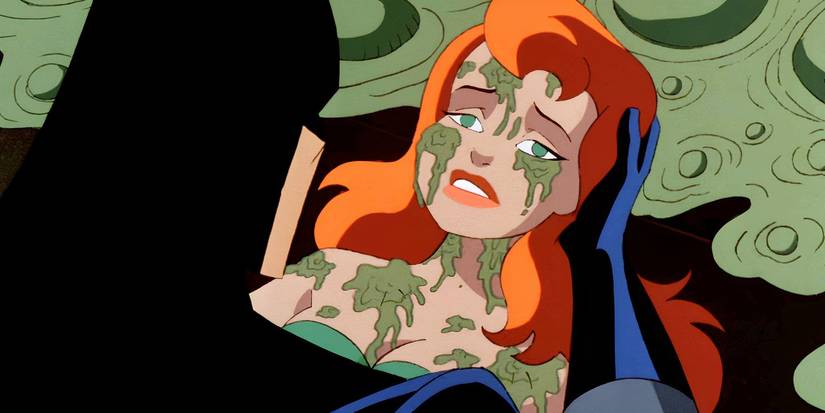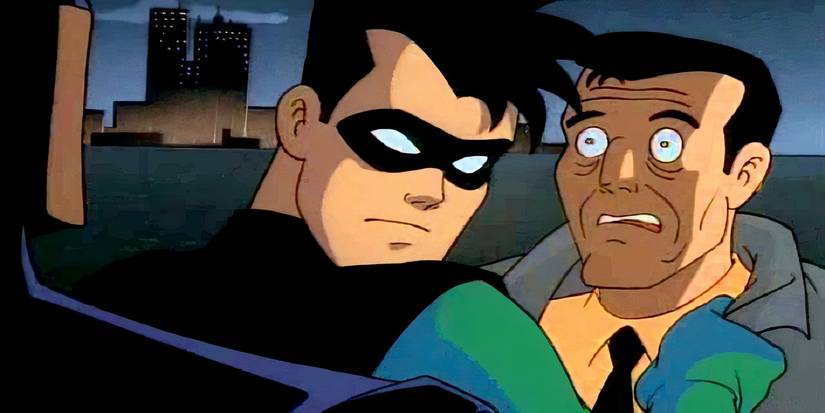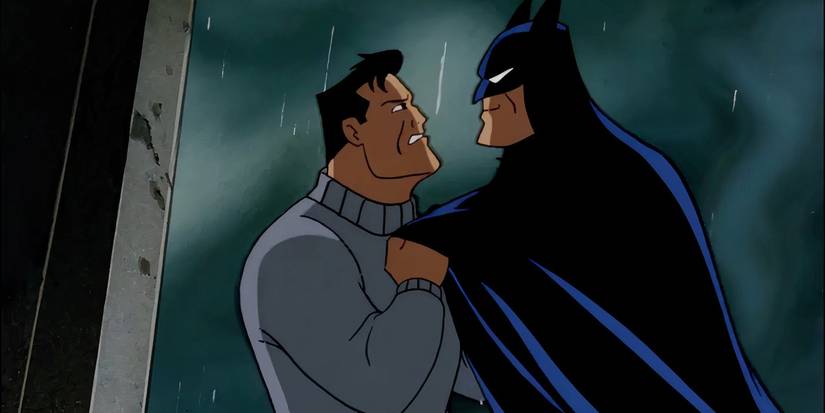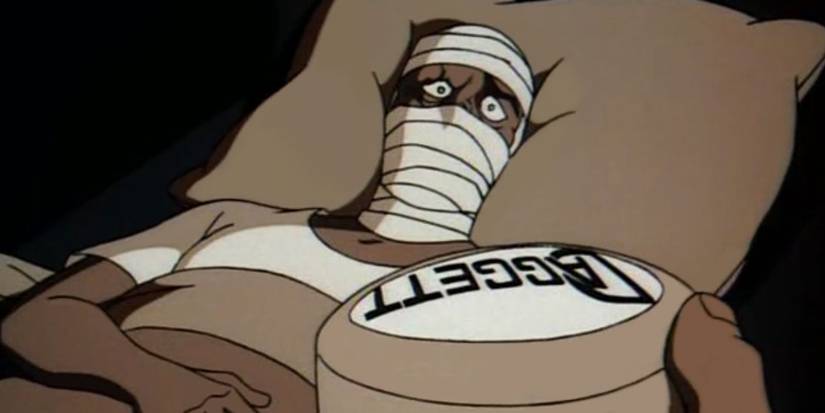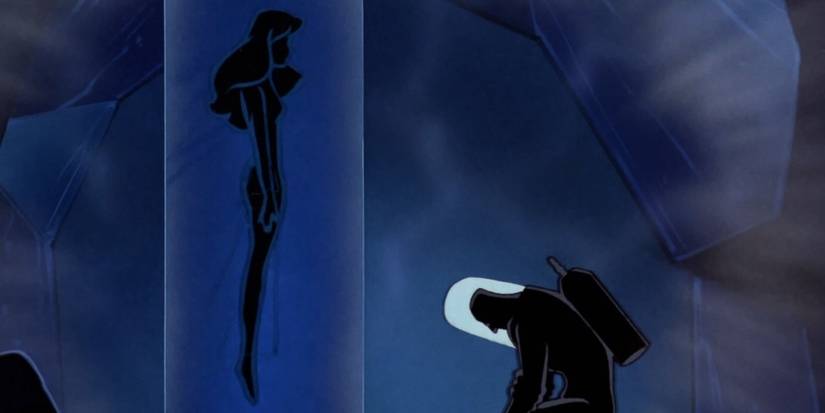Batman: The Animated Series pushed the boundaries of children’s television, delivering some of the darkest stories in DC’s animated history. Batman: TAS changed the superhero genre forever, with emotional depth and unforgettable psychological tension. While known for its iconic art style, Batman: TAS also delivered moments so shockingly dark that they lingered with viewers long after the credits.
These Batman: TAS scenes weren’t just unsettling. They elevated the show into a timeless, character-driven tragedy. The creative team never shied away from exploring trauma, identity, grief, or the frightening consequences of Gotham’s criminal world.
At its best, the show presented darkness not for shock value. It deepens its characters through moments of genuine vulnerability. It’s one of the many ways Batman: TAS influenced superhero series forever.
Joker’s Road Rage In “Joker’s Favor”
Batman: TAS season 1, episode 22, “Joker’s Favor” truly flaunts Joker’s terrifying potential. The episode opens with a man named Charlie Collins accidentally cursing at the Joker in traffic. What follows is pure nightmare fuel. Joker follows and pursues Charlie relentlessly, consistently reappearing with an eerie calm every time Charlie thinks he has given Joker the slip.
Joker’s calm reaction is far more disturbing than rage, becoming an impatient inevitability. It’s this unsettling calm that amplifies Joker’s menace. It feels like a (moderately) child-friendly rendition of the inescapable hitchhiker horror trope exemplified by The Twilight Zone and All Hallows’ Eve.
Ultimately, Joker demands Charlie’s name and declares that he will one day call upon him for a favor, sealing his fate with chilling casualness. For two years, Charlie has lived in fear, knowing Joker will return. It’s a terrifying portrait of the Joker’s power over ordinary people, leaving audiences shaken.
Poison Ivy’s Botanical Family In “House & Garden”
“House & Garden” begins with the shocking premise that Poison Ivy may have genuinely reformed, marrying and living a peaceful suburban life. The twist, however, transforms Batman: TAS season 2, episode 5, into one of the show’s most disturbing psychological horrors. Ivy’s new family (a husband and two sons) appears perfect until their grotesque botanical nature is revealed.
These plant-human hybrids are both uncanny and tragic. The horror deepens when viewers learn Ivy crafted them as replacements for the normal life she could never have. The longing behind her actions is heartbreaking, but the unnatural, slimy monstrosities she produced make the situation even more unsettling.
It’s a disturbing blend of maternal desire and warped science. Her “children” dissolving into plant matter is one of the show’s most disturbing visuals. Ivy’s desperate attempt to fabricate happiness ultimately exposes her profound loneliness, making the episode haunting on multiple levels.
Joker’s Improved Laughing Gas In “The Laughing Fish”
“The Laughing Fish” adapts one of the darkest Joker stories from the comics, and Batman: TAS season 1, episode 34 pulls no punches. Joker’s plan involves poisoning Gotham’s fish so they permanently bear his grin – a surreal, disturbing image that instantly sets the tone. His goal is to force the government to acknowledge his “copyright” in twisted fashion.
The story grows darker when Joker threatens to kill anyone involved in rejecting his claim. He deploys an improved Joker gas made of a binary compound. The previous Joker gas resulted in Batman: TAS‘s Gothamites laughing uncontrollably. However, this new mixture is deadly and causes victims to gain a rictus, Joker-style grin on their face, complete with yellow eyes and teeth.
This upgrade is a harrowing development. The sight of victims laughing uncontrollably while dying underscores the Joker’s cruelty. It’s a horrifying moment that elevated Joker’s villainy beyond petty theft and theatrical schemes.
Robot Batman Has An Existential Crisis In “His Silicon Soul”
Batman: TAS season 1, episode 62, “His Silicon Soul” explores existential horror in a way rarely seen in superhero animation. The robotic duplicate of Batman, created by HARDAC, initially appears as a simple villain returning from a previous storyline. However, the episode pivots into emotional devastation when the android begins to question its identity and morality.
Believing itself to be the real Batman, it experiences genuine confusion and anguish. As the robot uncovers HARDAC’s final command, it struggles between programming and a sense of free will. The conflict is heartbreaking because the android truly believes it embodies Batman’s principles.
Its internal battle mirrors a human crisis of purpose, blurring the line between machine and man. The ending, in which the duplicate sacrifices itself, is surprisingly emotional. When Batman reflects that the machine had “a soul,” the darkness of the tragedy becomes clear – a being that wanted to be good was doomed from inception.
Robin Almost Kills His Parents’ Killer In “Robin’s Reckoning”
“Robin’s Reckoning” is among Batman: TAS’s most acclaimed episodes, blending emotional storytelling with harrowing psychological conflict. In season 1, episodes 32-33, Dick Grayson learns that Batman has been pursuing Tony Zucco (the man responsible for his parents’ deaths). His grief resurfaces with a vengeance.
The flashbacks to the circus accident are gut-wrenching, setting the emotional foundation for Robin’s rage. As Robin tracks Zucco, his anger pushes him toward a darker path. His struggle isn’t just with vengeance, but with identity – whether he can uphold Batman’s principles when tested personally.
The tension builds as he corners Zucco, fists clenched, ready to kill. It’s one of the most chilling moments of moral crisis in the show. With Batman’s intervention, Robin ultimately steps back, but the scene highlights how easily pain can reshape a hero. The darkness lies in how close he came – and how deeply trauma still consumes him.
Batman Sees His Father As A Giant Monster In “Nothing To Fear”
“Nothing to Fear” delivers one of Batman: TAS’s most psychologically disturbing sequences. Exposed to Scarecrow’s fear toxin, Batman faces visions rooted in his deepest insecurities. The moment that left viewers speechless is the nightmare where Thomas Wayne appears, towering over Bruce as a monstrous, spectral figure.
Thomas condemns his son as a failure – an accusation more painful than any physical threat. The monstrous transformation combines guilt, fear, and self-loathing into a single terrifying image. Bruce’s lifelong mission stems from honoring his parents, making the hallucination particularly devastating.
It exposes how fragile he still is beneath his stoic exterior. The scene’s intensity surprises viewers with its emotional rawness. The moment becomes even darker when Batman admits he sometimes believes the accusation. His vulnerability is rarely shown so openly, and the fear of disappointing his father becomes one of the series’ most haunting emotional beats.
Batman Watching His Parents Die Again in “Dreams in Darkness”
In Batman: TAS, “Dreams in Darkness,” Batman is once again exposed to Scarecrow’s fear toxin. However, this episode takes his psychological torment to an even more disturbing level. Institutionalized and unable to convince anyone he’s sane, Batman spirals into visions that trap him between reality and nightmare.
The most devastating moment comes when he’s forced to relive the murder of Thomas and Martha Wayne. The scene is stylized through the toxin’s influence, making the memory even more grotesque and haunting. The distortion amplifies Bruce’s trauma, reminding viewers that the wound is still raw despite years of crime fighting.
It’s a rare moment where Batman is powerless against his own mind, unable to escape the foundational tragedy of his life. Watching the event replay, twisted and unavoidable, reveals the ongoing psychological burden he carries. It’s a chilling reminder that some nightmares never fade – even for Batman.
Baby Doll’s Breakdown in “Baby-Doll”
“Baby-Doll” is one of Batman: TAS’s most surprising tragedies. At first, the original Batman: TAS character Mary Dahl appears to be a bizarre, gimmicky villain. Yet the episode reveals her heartbreaking struggle with a rare condition that keeps her physically trapped in the body of a child.
Her loneliness and frustration build throughout the story, but it’s the climax – where she faces a distorted funhouse mirror – that delivers one of the darkest emotional collapses in the series. Seeing her adult reflection for the first time, Mary becomes overwhelmed. She fires her gun repeatedly at the image of the woman she can never become.
The moment is shocking, raw, and deeply sympathetic, capturing a lifetime of internalized pain bursting out all at once. Her sobbing breakdown in Batman’s arms is devastating. Few episodes showcase such profound psychological suffering, making this one of Batman: TAS’s most haunting moments.
Clayface’s Agonizing Mutation in “Feat of Clay, Part II”
Clayface’s transformation sequence in Batman: TAS season 1, episode 21, “Feat of Clay, Part II” remains one of the most disturbingly animated scenes in the entire series. As Matt Hagen’s body mutates uncontrollably, viewers see the agonizing distortion of his features. He’s stretched, melted, reshaped against his will.
The horror lies not just in the animation, but in the sheer brutality of watching a man lose control of his own form. The sequence feels like body horror straight out of a mature film, pushing boundaries for children’s television. Hagen’s screams, confusion, and panic make the transformation emotionally excruciating.
His mind deteriorates along with his body, highlighting the tragedy of a man who never wanted this fate. Clayface’s final acceptance of his monstrous form is equally haunting. The episode transforms a villain’s origin into a tragic commentary on identity, loss, and the despair of becoming something unrecognizable.
Mr. Freeze’s Tragic Coma Revelation in “Heart of Ice”
“Heart of Ice” is widely regarded as one of Batman: TAS’s greatest episodes. Its darkest and most poignant moment remains the revelation that Nora Fries is preserved in a cryogenic coma because of Victor’s obsession and suffering. The imagery of Nora suspended in ice is haunting, serving as a quiet symbol of Victor’s emotional devastation.
Her condition redefines Mr. Freeze not as a typical villain but as a tragic figure consumed by grief. The discovery that corporate greed disrupted his desperate attempt to save her adds another layer of cruelty. Victor’s transformation into Mr. Freeze becomes a heartbreaking response to unimaginable loss.
The scene forces viewers to confront the fragility of love when corrupted by tragedy and science. His final monologue, spoken in cold monotone, underscores the emotional tragedy. The darkness doesn’t lie in violence but in the unbearable weight of Freeze’s sorrow – a wound that never heals in Batman: The Animated Series.

- Release Date
-
1992 – 1995-00-00
- Network
-
FOX, Fox Kids
- Showrunner
-
Bruce Timm
-

-

Efrem Zimbalist Jr.
Alfred Pennyworth (voice)


